The Response of Soil Physicochemical Properties in the Hyrcanian Forests of Iran to Forest Fire Events
Abstract
1. Introduction
2. Materials and Methods
2.1. Site Description
2.2. Study Area, Data Collection and Soil Sampling
2.3. Measurement of Soil Physical Properties
2.3.1. Soil Hydrophobicity Measurement
2.3.2. Soil Permeability
2.4. Measurement of Soil Chemical Properties
2.5. Statistical Analysis
3. Results
3.1. Physical and Chemical Properties of The Soil
3.2. Soil Chemical Properties
4. Discussion
4.1. The Effect of Fire on Soil Physical Characteristics
4.2. The Effect of Fire on Soil Chemical Characteristics
5. Conclusions
Author Contributions
Funding
Institutional Review Board Statement
Informed Consent Statement
Data Availability Statement
Conflicts of Interest
References
- Zhao, D.; Xu, M.; Liu, G.; Ma, L.; Zhang, S.; Xiao, T.; Peng, G. Effect of vegetation type on microstructure of soil aggregates on the Loess Plateau, China. Agric. Ecosyst. Environ. 2017, 242, 1–8. [Google Scholar] [CrossRef]
- Heimsath, A.M.; DiBiase, R.A.; Whipple, K.X. Soil production limits and the transition to bedrock-dominated landscapes. Nat. Geosci. 2012, 5, 210–214. [Google Scholar] [CrossRef]
- Lai, X.; Zhu, Q.; Castellano, M.J.; Liao, K. Soil rock fragments: Unquantified players in terrestrial carbon and nitrogen cycles. Geoderma 2022, 406, 115530. [Google Scholar] [CrossRef]
- Kennard, D.K.; Gholz, H.L. Effects of high-and low-intensity fires on soil properties and plant growth in a Bolivian dry forest. Plant Soil 2001, 234, 119–129. [Google Scholar] [CrossRef]
- Cusack, D.F.; Karpman, J.; Ashdown, D.; Cao, Q.; Ciochina, M.; Halterman, S.; Lydon, S.; Neupane, A. Global change effects on humid tropical forests: Evidence for biogeochemical and biodiversity shifts at an ecosystem scale. Rev. Geophys. 2016, 54, 523–610. [Google Scholar] [CrossRef]
- Jhariya, M.K.; Singh, L. Effect of fire severity on soil properties in a seasonally dry forest ecosystem of Central India. Int. J. Environ. Sci. Technol. 2021, 18, 3967–3978. [Google Scholar] [CrossRef]
- Kavian, A.; Allahi, E.; Ziegler, A.D.; Mohamadi, M.A.; Zabihzadeh, S.M.; Hazbavi, Z. Effectiveness of native wood strand mulches for land rehabilitation in Iran under experimental conditions. Land Degrad. Dev. 2020, 31, 581–590. [Google Scholar] [CrossRef]
- Rodrigo-Comino, J.; López-Vicente, M.; Kumar, V.; Rodríguez-Seijo, A.; Valkó, O.; Rojas, C.; Pourghasemi, H.R.; Salvati, L.; Bakr, N.; Vaudour, E.; et al. Soil Science Challenges in a New Era: A Transdisciplinary Overview of Relevant Topics. Air Soil Water Res. 2020, 13, 1178622120977491. [Google Scholar] [CrossRef]
- Fernandez-Anez, N.; Krasovskiy, A.; Müller, M.; Vacik, H.; Baetens, J.; Hukić, E.; Kapovic Solomun, M.; Atanassova, I.; Glushkova, M.; Bogunović, I.; et al. Current Wildland Fire Patterns and Challenges in Europe: A Synthesis of National Perspectives. Air Soil Water Res. 2021, 14, 11786221211028184. [Google Scholar] [CrossRef]
- Komarasamy, D.; Gokuldhev, M.; Hermina, J.J.; Gokulapriya, M.; Manju, M. Review for Detecting Smoke and Fire in Forest using Different Technologies. IOP Conf. Ser. Mater. Sci. Eng. 2020, 993, 012056. [Google Scholar] [CrossRef]
- Ghazoul, J.; Burivalova, Z.; Garcia-Ulloa, J.; King, L.A. Conceptualizing forest degradation. Trends Ecol. Evol. 2015, 30, 622–632. [Google Scholar] [CrossRef] [PubMed]
- Silvério, D.V.; Brando, P.M.; Bustamante, M.M.; Putz, F.E.; Marra, D.M.; Levick, S.R.; Trumbore, S.E. Fire, fragmentation, and windstorms: A recipe for tropical forest degradation. J. Ecol. 2019, 107, 656–667. [Google Scholar] [CrossRef]
- Mataix-Solera, J. Alteraciones físicas, químicas y biológicas en suelos afectados por incendios forestales. Contribución a su Conservación y Regeneración. Facultad de Ciencias. Ph.D. Thesis, Universidad de Alicante, Alicante, Spain, 1999. [Google Scholar]
- Bond-Lamberty, B.; Peckham, S.D.; Ahl, D.E.; Gower, S.T. Fire as the dominant driver of central Canadian boreal forest carbon balance. Nature 2007, 450, 89–92. [Google Scholar] [CrossRef] [PubMed]
- Ulery, A.L.; Graham, R.C.; Goforth, B.R.; Hubbert, K.R. Fire effects on cation exchange capacity of California forest and woodland soils. Geoderma 2017, 286, 125–130. [Google Scholar] [CrossRef]
- Kong, J.J.; Yang, J.; Cai, W. Topography controls post-fire changes in soil properties in a Chinese boreal forest. Sci. Total Environ. 2019, 651, 2662–2670. [Google Scholar] [CrossRef] [PubMed]
- De Groot, W.J.; Flannigan, M.D.; Cantin, A.S. Climate change impacts on future boreal fire regimes. For. Ecol. Manag. 2013, 294, 35–44. [Google Scholar] [CrossRef]
- Lucas-Borja, M.E.; Delgado-Baquerizo, M.; Muñoz-Rojas, M.; Plaza-Álvarez, P.A.; Gómez-Sanchez, M.E.; González-Romero, J.; Peña-Molina, E.; Moya, D.; de las Heras, J. Changes in ecosystem properties after post-fire management strategies in wildfire-affected Mediterranean forests. J. Appl. Ecol. 2021, 58, 836–846. [Google Scholar] [CrossRef]
- Xanthopoulos, G.; Athanasiou, M.; Nikiforaki, A.; Kaoukis, K.; Mantakas, G.; Xanthopoulos, P.; Varela, V. Innovative Action for Forest Fire Prevention in Kythira Island, Greece, through Mobilization and Cooperation of the Population: Methodology and Challenges. Sustainability 2022, 14, 594. [Google Scholar] [CrossRef]
- Archibald, S.; Lehmann, C.E.; Belcher, C.M.; Bond, W.J.; Bradstock, R.A.; Daniau, A.L.; Dexter, K.G.; Forrestel, E.J.; Greve, M.; He, T.; et al. Biological and geophysical feedbacks with fire in the Earth system. Environ. Res. Lett. 2018, 13, 033003. [Google Scholar] [CrossRef]
- Balch, J.K.; Bradley, B.A.; Abatzoglou, J.T.; Nagy, R.C.; Fusco, E.J.; Mahood, A.L. Human-started wildfires expand the fire niche across the United States. Proc. Natl. Acad. Sci. USA 2017, 114, 2946–2951. [Google Scholar] [CrossRef]
- Lucas-Borja, M.E.; Ortega, R.; Miralles, I.; Plaza-Álvarez, P.A.; González-Romero, J.; Peña-Molina, E.; De las Heras, J. Effects of wildfire and logging on soil functionality in the short-term in Pinus halepensis M. forests. Eur. J. For. Res. 2020, 139, 935–945. [Google Scholar] [CrossRef]
- Vadrevu, K.P.; Eaturu, A.; Badarinath, K. Fire risk evaluation using multicriteria analysis—A case study. Environ. Monit. Assess. 2010, 166, 223–239. [Google Scholar] [CrossRef] [PubMed]
- Sepehri, Z.; Jafarian, Z.; Kavian, A.; Heydari, G. Effect ash and coal produced from fire on some of soil properties especially water retention. J. Water Soil Sci. 2017, 21, 145–157. [Google Scholar] [CrossRef]
- Eskandari, S.; Oladi, J.; Jalilvand, H.; Sarajian, M.R. Role of human factors on fire occurrence in District Three of Neka Zalemroud forests-Iran. World Appl. Sci. J. 2013, 27, 1146–1150. [Google Scholar]
- Fonseca, F.; de Figueiredo, T.; Nogueira, C.; Queirós, A. Effect of prescribed fire on soil properties and soil erosion in a Mediterranean mountain area. Geoderma 2017, 307, 172–180. [Google Scholar] [CrossRef]
- Lucas-Borja, M.E.; González-Romero, J.; Plaza-Álvarez, P.A.; Sagra, J.; Gómez, M.E.; Moya, D.; Cerdà, A.; de Las Heras, J. The impact of straw mulching and salvage logging on post-fire runoff and soil erosion generation under Mediterranean climate conditions. Sci. Total Environ. 2019, 654, 441–451. [Google Scholar] [CrossRef]
- García-Comendador, J.; Martínez-Carreras, N.; Fortesa, J.; Borràs, A.; Calsamiglia, A.; Estrany, J. Analysis of post-fire suspended sediment sources by using colour parameters. Geoderma 2020, 379, 114638. [Google Scholar] [CrossRef]
- Akhzari, D.; Mohammadi, E.; Saedi, K. Studying the effect of fire on some vegetation and soil properties in a semi-arid shrubland (Case study: Kachaleh Rangelands, Kamyaran Region). Ecopersia 2022, 10, 27–35. [Google Scholar]
- Neary, D.G.; Klopatek, C.C.; Debano, L.F.; and Ffolliott, P.F. Fire effects on belowground sustainability: A review and synthesis. For. Ecol. Manag. 1999, 844, 28–98. [Google Scholar] [CrossRef]
- Certini, G. Effects of fire on properties of forest soils: A review. Oecologia 2005, 143, 1–10. [Google Scholar] [CrossRef]
- Dooley, S.R.; Treseder, K.K. The effect of fire on microbial biomass: A meta-analysis of field studies. Biogeochemistry 2012, 109, 49–61. [Google Scholar] [CrossRef]
- Singh, D.; Sharma, P.; Kumar, U.; Daverey, A.; Arunachalam, K. Effect of forest fire on soil microbial biomass and enzymatic activity in oak and pine forests of Uttarakhand Himalaya, India. Ecol. Processes 2021, 10, 29. [Google Scholar] [CrossRef]
- Toledo-Castro, J.; Caballero-Gil, P.; Rodríguez-Pérez, N.; Santos-González, I.; Hernández-Goya, C.; Aguasca-Colomo, R. Forest fire prevention, detection, and fighting based on fuzzy logic and wireless sensor networks. Complexity 2018, 2018, 1–17. [Google Scholar] [CrossRef]
- Hubbert, K.R.; Preisler, H.K.; Wohlgemuth, P.M.; Graham, R.C.; Narog, M.G. Prescribed burning effects on soil physical properties and soil water repellency in a steep chaparral watershed, southern California, USA. Geoderma 2006, 130, 284–298. [Google Scholar] [CrossRef]
- Brais, S.; David, P.; Ouimet, R. Impacts of wild fire severity and salvage harvesting on the nutrient balance of jack pine and black spruce boreal stands. For. Ecol. Manag. 2000, 137, 231–243. [Google Scholar] [CrossRef]
- Turner, M.G.; Smithwick, E.A.; Metzger, K.L.; Tinker, D.B.; Romme, W.H. Inorganic nitrogen availability after severe stand-replacing fire in the Greater Yellowstone ecosystem. Proc. Natl. Acad. Sci. USA 2007, 104, 4782–4789. [Google Scholar] [CrossRef]
- The World Bank. Iran, Islamic Republic of—Cost Assessment of Environmental Degradation 1; The World Bank: Washington, DC, USA, 2005. [Google Scholar]
- Emadodin, I.; Narita, D.; Bork, H.R. Soil degradation and agricultural sustainability: An overview from Iran. Environ. Dev. Sustain. 2012, 14, 611–625. [Google Scholar] [CrossRef]
- Eskandari, S. Investigation on the relationship between climate change and fire in the forests of Golestan Province. Iran. J. For. Range Prot. Res. 2015, 13, 1–10. [Google Scholar]
- Food and Agriculture Organization of the United Nations. State of the World’s Forests 2007; Food and Agriculture Organization of the United Nations Press: Rome, Italy, 2007. [Google Scholar]
- Jafarian, Z.; Sepehri, Z. Effect of Fire Intensity on Infiltration Components of Soil in Different Seasons (Case Study: Rangeland Charat sub Watershed in Mazandaran Province). J. Watershed Manag. Res. 2018, 9, 206–215. [Google Scholar] [CrossRef]
- Magomani, M.I.; van Tol, J.J. The impact of fire frequency on selected soil physical properties in a semi-arid savannah Thornveld. Acta Agric. Scand. Sect. B—Soil Plant Sci. 2019, 69, 43–51. [Google Scholar] [CrossRef]
- Alli, I.; Ebrahimi, M.S.; Davari, M. Temporal variations of runoff, erosion and soil nutrients affected by fires in oak forests of Lake Zaribar. Watershed Manag. Res. 2020, 33, 52–65. [Google Scholar]
- Arunrat, N.; Sereenonchai, S.; Hatano, R. Effects of fire on soil organic carbon, soil total nitrogen, and soil properties under rotational shifting cultivation in northern Thailand. J. Environ. Manag. 2022, 302, 113978. [Google Scholar] [CrossRef] [PubMed]
- Zarandian, A.; Baral, H.; Yavari, A.R.; Jafari, H.R.; Stork, N.E.; Ling, M.A.; Amirnejad, H. Anthropogenic decline of ecosystem services threatens the integrity of the unique Hyrcanian (Caspian) forests in Northern Iran. Forests 2016, 7, 51. [Google Scholar] [CrossRef]
- Hyun, B.K.; Kim, M.S.; Eom, K.C.; Jo, I.S. A more simplified hydrometer method for soil texture analysis. Korean J. Soil Sci. Fertil. 2000, 33, 153–159. [Google Scholar]
- Acevedo, S.E.; Contreras, C.P.; Ávila, C.J.; Bonilla, C.A. Testing the integral suspension pressure method for soil particle size analysis across a range of soil organic matter contents. Int. Agrophysics 2021, 35, 357–363. [Google Scholar] [CrossRef]
- Rossi, A.M.; Hirmas, D.R.; Graham, R.C.; Sternberg, P.D. Bulk density determination by automated three-dimensional laser scanning. Soil Sci. Soc. Am. J. 2008, 72, 1591–1593. [Google Scholar] [CrossRef]
- Damptey, F.G.; Birkhofer, K.; Nsiah, P.K.; de la Riva, E.G. Soil properties and biomass attributes in a former gravel mine area after two decades of forest restoration. Land 2020, 9, 209. [Google Scholar] [CrossRef]
- Doerr, S.H.; Douglas, P.; Evans, R.C.; Morley, C.P.; Mullinger, N.J.; Bryant, R.; Shakesby, R.A. Effects of heating and post-heating equilibration times on soil water repellency. Soil Res. 2005, 43, 261–267. [Google Scholar] [CrossRef]
- Madsen, M.D.; Zvirzdin, D.L.; Petersen, S.L.; Hopkins, B.G.; Roundy, B.A.; Chandler, D.G. Soil water repellency within a burned piñon–juniper woodland: Spatial distribution, severity, and ecohydrologic implications. Soil Sci. Soc. Am. J. 2011, 75, 1543–1553. [Google Scholar] [CrossRef]
- Leelamanie, D.A.L.; Karube, J.; Yoshida, A. Characterizing water repellency indices: Contact angle and water drop penetration time of hydrophobized sand. Soil Sci. Plant Nutr. 2008, 54, 179–187. [Google Scholar] [CrossRef]
- Hewelke, E.; Gozdowski, D.; Korc, M.; Małuszyńska, I.; Górska, E.B.; Sas, W.; Mielnik, L. Influence of soil moisture on hydrophobicity and water sorptivity of sandy soil no longer under agricultural use. CATENA 2022, 208, 105780. [Google Scholar] [CrossRef]
- Salifu, E.; El Mountassir, G. Fungal-induced water repellency in sand. Géotechnique 2021, 71, 608–615. [Google Scholar] [CrossRef]
- Paltineanu, C.; Vrinceanu, A.; Lăcătușu, A.R.; Lăcătuşu, R.; Domnariu, H.; Marica, D.; Vizitiu, O. An improved method to study solute leaching in large undisturbed soil columns near field capacity toward the groundwater in various environments. Carpathian J. Earth Environ. Sci. 2020, 15, 93–102. [Google Scholar] [CrossRef] [PubMed]
- Boeno, D.; Gubiani, P.I.; Lier, Q.D.J.V.; Mulazzani, R.P. Estimating lateral flow in double ring infiltrometer measurements. Rev. Bras. De Ciência Do Solo 2021, 45. Available online: https://www.scielo.br/j/rbcs/a/wd3QXpTVp7M3qPBCzdVzZ7d/?lang=en&%3Bformat=pdf (accessed on 10 September 2022). [CrossRef]
- Gregory, J.H.; Dukes, M.D.; Miller, G.L.; Jones, P.H. Analysis of double-ring infiltration techniques and development of a simple automatic water delivery system. Appl. Turfgrass Sci. 2005, 2, 1–7. [Google Scholar] [CrossRef]
- Li, M.; Liu, T.; Duan, L.; Luo, Y.; Ma, L.; Zhang, J.; Zhou, Y.; Chen, Z. The scale effect of double-ring infiltration and soil infiltration zoning in a semi-arid steppe. Water 2019, 11, 1457. [Google Scholar] [CrossRef]
- Khasraei, A.; Abyaneh, H.Z.; Jovzi, M.; Albaji, M. Determining the accuracy of different water infiltration models in lands under wheat and bean cultivation. J. Hydrol. 2021, 603, 127122. [Google Scholar] [CrossRef]
- Dahak, A.; Boutaghane, H.; Merabtene, T. Parameter Estimation and Assessment of Infiltration Models for Madjez Ressoul Catchment, Algeria. Water 2022, 14, 1185. [Google Scholar] [CrossRef]
- Behnood, A.; van Tittelboom, K.; De Belie, N. Methods for measuring pH in concrete: A review. Constr. Build. Mater. 2016, 105, 176–188. [Google Scholar] [CrossRef]
- Campitelli, P.A.; Velasco, M.I.; Ceppi, S.B. Chemical and physicochemical characteristics of humic acids extracted from compost, soil and amended soil. Talanta 2006, 69, 1234–1239. [Google Scholar] [CrossRef]
- Xie, Z.; Yang, X.; Sun, X.; Huang, L.; Li, S.; Hu, Z. Effects of biochar application and irrigation rate on the soil phosphorus leaching risk of fluvisol profiles in open vegetable fields. Sci. Total Environ. 2021, 789, 147973. [Google Scholar] [CrossRef] [PubMed]
- Walkley, A.; Black, I.A. An examination of the Degtjareff method for determining soil organic matter, and a proposed modification of the chromic acid titration method. Soil Sci. 1934, 37, 29–38. [Google Scholar] [CrossRef]
- Shura, G.; Beshir, H.M.; Haile, A. Improving onion productivity through optimum and economical use of soil macronutrients in Central Rift Valley of Ethiopia. J. Agric. Food Res. 2022, 9, 100321. [Google Scholar] [CrossRef]
- Ram, B.; Singh, A.P.; Singh, V.K.; Luthra, N.; Nath, A. Effect of different land uses on chemical properties of soil in a Mollisol. Pharma J. 2022, 11, 242–246. [Google Scholar]
- Moosavi-Nasab, M.; Khoshnoudi-Nia, S.; Azimifar, Z.; Kamyab, S. Evaluation of the total volatile basic nitrogen (TVB-N) content in fish fillets using hyperspectral imaging coupled with deep learning neural network and meta-analysis. Sci. Rep. 2021, 11, 5094. [Google Scholar] [CrossRef] [PubMed]
- Zhang, J.; Zhao, Y.; Xin, Y. Changes in and evaluation of surface soil quality in Populus× xiaohei shelterbelts in midwestern Heilongjiang province, China. J. For. Res. 2021, 32, 1221–1233. [Google Scholar] [CrossRef]
- Cheng, H.; Zhu, X.; Sun, R.; Niu, Y.; Yu, Q.; Shen, Y.; Li, S. Effects of different mulching and fertilization on phosphorus transformation in upland farmland. J. Environ. Manag. 2020, 253, 109717. [Google Scholar] [CrossRef]
- Morel, C.; Plénet, D.; Mollier, A. Calibration of maize phosphorus status by plant-available soil P assessed by common and process-based approaches. Is it soil-specific or not? Eur. J. Agron. 2021, 122, 126174. [Google Scholar] [CrossRef]
- Ai-Ping, W.A.N.G.; Fa-Hu, L.I.; Sheng-Min, Y.A.N.G. Effect of polyacrylamide application on runoff, erosion, and soil nutrient loss under simulated rainfall. Pedosphere 2011, 21, 628–638. [Google Scholar]
- Garvin, H.M.; Dunn, R.; Sholts, S.B.; Litten, M.S.; Mohamed, M.; Kuttickat, N.; Skantz, N. Forensic Tools for Species Identification of Skeletal Remains: Metrics, Statistics, and Osteoid. Biology 2022, 11, 25. [Google Scholar] [CrossRef]
- Bertoldo, G.; Callegher, C.Z.; Altoè, G. Designing studies and evaluating research results: Type M and Type S Errors for pearson correlation coefficient. Meta-Psychol. 2022, 6. Available online: https://doi.org/10.15626/MP.2020.2573 (accessed on 10 September 2022). [CrossRef]
- Arcenegui, V.; Mataix-Solera, J.; Guerrero, C.; Zornoza, R.; Mataix-Beneyto, J.; García-Orenes, F. Immediate effects of wildfires on water repellency and aggregate stability in Mediterranean calcareous soils. CATENA 2008, 74, 219–226. [Google Scholar] [CrossRef]
- Mataix-Solera, J.; Cerdà, A.; Arcenegui, V.; Jordán, A.; Zavala, L.M. Fire effects on soil aggregation: A review. Earth-Sci. Rev. 2011, 109, 44–60. [Google Scholar] [CrossRef]
- Peduto, D.; Iervolino, L.; Foresta, V. Experimental Analysis of the Fire-Induced Effects on the Physical, Mechanical, and Hydraulic Properties of Sloping Pyroclastic Soils. Geosciences 2022, 12, 198. [Google Scholar] [CrossRef]
- Rodríguez, A.R.; Arbelo, C.D.; Guerra, J.A.; Mora, J.L.; Notario, J.S.; Armas, C.M. Organic carbon stocks and soil erodibility in Canary Islands Andosols. CATENA 2006, 66, 228–235. [Google Scholar] [CrossRef]
- Garrido-Ruiz, C.; Sandoval, M.; Stolpe, N.; Sanchez-Hernandez, J.C. Fire impacts on soil and post fire emergency stabilization treatments in Mediterranean-climate regions. Chil. J. Agric. Res. 2022, 82, 335–347. [Google Scholar] [CrossRef]
- Vogelmann, E.S.; Reichert, J.M.; Prevedello, J.; Consensa, C.O.B.; Oliveira, A.É.; Awe, G.O.; Mataix-Solera, J. Threshold water content beyond which hydrophobic soils become hydrophilic: The role of soil texture and organic matter content. Geoderma 2013, 209, 177–187. [Google Scholar] [CrossRef]
- Schaumann, G.E.; Braun, B.; Kirchner, D.; Rotard, W.; Szewzyk, U.; Grohmann, E. Influence of biofilms on the water repellency of urban soil samples. Hydrol. Process. Int. J. 2007, 21, 2276–2284. [Google Scholar] [CrossRef]
- Robichaud, P.R. Fire effects on infiltration rates after prescribed fire in Northern Rocky Mountain forests, USA. J. Hydrol. 2000, 231, 220–229. [Google Scholar] [CrossRef]
- Stoof, C.R.; Ferreira, A.J.; Mol, W.; van den Berg, J.; de Kort, A.; Drooger, S.; Slingerland, E.c.; Mansholt, A.U.; Ritsema, C.J. Soil surface changes increase runoff and erosion risk after a low–moderate severity fire. Geoderma 2015, 239, 58–67. [Google Scholar] [CrossRef]
- Malvar, M.C.; Silva, F.C.; Prats, S.A.; Vieira, D.C.; Coelho, C.O.; Keizer, J.J. Short-term effects of post-fire salvage logging on runoff and soil erosion. For. Ecol. Manag. 2017, 400, 555–567. [Google Scholar] [CrossRef]
- Heydari, M.; Rostamy, A.; Najafi, F.; Dey, D.C. Effect of fire severity on physical and biochemical soil properties in Zagros oak (Quercus brantii Lindl.) forests in Iran. J. For. Res. 2017, 28, 95–104. [Google Scholar] [CrossRef]
- Agbeshie, A.A.; Abugre, S.; Atta-Darkwa, T.; Awuah, R. A review of the effects of forest fire on soil properties. J. For. Res. 2022, 33, 1419–1441. [Google Scholar] [CrossRef]
- Granged, A.J.; Zavala, L.M.; Jordán, A.; Bárcenas-Moreno, G. Post-fire evolution of soil properties and vegetation cover in a Mediterranean heathland after experimental burning: A 3-year study. Geoderma 2011, 164, 85–94. [Google Scholar] [CrossRef]
- Montoya, S.; Marín, G.; Ortega, E. Impact of prescribed burning on soil properties in a Mediterranean area (Granada, SW Spain). Span. J. Soil Sci. 2014, 4, 88–98. [Google Scholar]
- Hamman, S.T.; Burke, I.C.; Knapp, E.E. Soil nutrients and microbial activity after early and late season prescribed burns in a Sierra Nevada mixed conifer forest. For. Ecol. Manag. 2008, 256, 367–374. [Google Scholar] [CrossRef]
- Chowdhury, S.; Manjón-Cabeza, J.; Ibáñez, M.; Mestre, C.; Broncano, M.J.; Mosquera-Losada, M.R.; Plaixats, J.; Sebastià, M.T. Responses in Soil Carbon and Nitrogen Fractionation after Prescribed Burning in the Montseny Biosphere Reserve (NE Iberian Peninsula). Sustainability 2022, 14, 4232. [Google Scholar] [CrossRef]
- Norouzi, M.; Ramezanpour, H.; Rabiei, B.; Asadi, H. Effects of Flooding and Fire on Aggregate Stability: A Case Study in the Soils of Lakan Nursery in Guilan Province. Iran. J. Soil Res. 2013, 27, 415–426. [Google Scholar]
- Cerdà, A.; Doerr, S.H. Influence of vegetation recovery on soil hydrology and erodibility following fire: An 11-year investigation. Int. J. Wildland Fire 2005, 14, 423–437. [Google Scholar] [CrossRef]
- Fultz, L.M.; Moore-Kucera, J.; Dathe, J.; Davinic, M.; Perry, G.; Wester, D.; Schwilk, D.W.; Rideout-Hanzak, S. Forest wildfire and grassland prescribed fire effects on soil biogeochemical processes and microbial communities: Two case studies in the semi-arid Southwest. Appl. Soil Ecol. 2016, 99, 118–128. [Google Scholar] [CrossRef]
- Holden, S.R.; Gutierrez, A.; Treseder, K.K. Changes in soil fungal communities, extracellular enzyme activities, and litter decomposition across a fire chronosequence in Alaskan boreal forests. Ecosystems 2013, 16, 34–46. [Google Scholar] [CrossRef]
- Tessler, N.; Wittenberg, L.; Malkinson, D. The development and the breakdown of hydrophobic layer after forest fires in mt. carmel, israel. In Proceedings of the International Meeting of Fire Effects on Soil Properties, Barcelona, Spain, 31 January–3 February 2007; Available online: https://scholar.google.com/scholar?hl=en&as_sdt=0%2C5&q=The+development+and+the+breakdown+of+hydrophobic+layer+after+forest+fires+in+mt.+carmel%2C+israel.+in+proceedings+of+the+in-ternational+meeting+of+fire+effects+on+soil+properties&btnG= (accessed on 10 September 2022).
- Robichaud, P.R.; Wagenbrenner, J.W.; Pierson, F.B.; Spaeth, K.E.; Ashmun, L.E.; Moffet, C.A. Infiltration and interrill erosion rates after a wildfire in western Montana, USA. CATENA 2016, 142, 77–88. [Google Scholar] [CrossRef]
- Zheng, W.; Morris, E.K.; Lehmann, A.; Rillig, M.C. Interplay of soil water repellency, soil aggregation and organic carbon. A meta-analysis. Geoderma 2016, 283, 39–47. [Google Scholar] [CrossRef]
- Kara, O.; Bolat, I. Short-term effects of wildfire on microbial biomass and abundance in black pine plantation soils in Turkey. Ecol. Indic. 2009, 9, 1151–1155. [Google Scholar] [CrossRef]
- Heydari, M.; Faramarzi, M.; Pothier, D. Post-fire recovery of herbaceous species composition and diversity, and soil quality indicators one year after wildfire in a semi-arid oak woodland. Ecol. Eng. 2016, 94, 688–697. [Google Scholar] [CrossRef]
- Luo, S.S.L.B.Z.; Hu, S.J.W.H.Q.; Wu, X.C.L.Z.P.; Zhou, Z.S.W.Y.F.; Zhong, Y.X. Effects of forest fires on soil organic carbon density in secondary forest of Pinus massoniana. Chin. J. Plant Ecol. 2020, 44, 1073. [Google Scholar] [CrossRef]
- Vermeire, L.T.; Wester, D.B.; Mitchell, R.B.; Fuhlendorf, S.D. Fire and grazing effects on wind erosion, soil water content, and soil temperature. J. Environ. Qual. 2005, 34, 1559–1565. [Google Scholar] [CrossRef]
- Gómez-Rey, M.X.; Couto-Vázquez, A.; García-Marco, S.; González-Prieto, S.J. Impact of fire and post-fire management techniques on soil chemical properties. Geoderma 2013, 195, 155–164. [Google Scholar] [CrossRef]
- Badía, D.; Martí, C.; Aguirre, A.J.; Aznar, J.M.; González-Pérez, J.A.; De la Rosa, J.M.; León, L.; Ibarra, P.; Echeverría, T. Wildfire effects on nutrients and organic carbon of a Rendzic Phaeozem in NE Spain: Changes at cm-scale topsoil. CATENA 2014, 113, 267–275. [Google Scholar] [CrossRef]
- Delijani, N.B.; Moshki, A.; Matinizadeh, M.; Ravanbakhsh, H.; Nouri, E. The effects of fire and seasonal variations on soil properties in Juniperus excelsa M. Bieb. stands in the Alborz Mountains, Iran. J. For. Res. 2022, 33, 1471–1479. [Google Scholar] [CrossRef]
- Alcañiz, M.; Outeiro, L.; Francos, M.; Úbeda, X. Effects of prescribed fires on soil properties: A review. Sci. Total Environ. 2018, 613, 944–957. [Google Scholar] [CrossRef] [PubMed]
- Asadian, G.; Khataar, M.; Siahmansour, R.; Ahmadian, M. Effect of fire on soil chemical and physical properties in the Solan rangelands, Hamadan Province, Iran. Iran Nat. 2021, 6, 67–73. [Google Scholar]
- Bárcenas-Moreno, G.; García-Orenes, F.; Mataix-Solera, J.; Mataix-Beneyto, J.; Bååth, E. Soil microbial recolonisation after a fire in a Mediterranean forest. Biol. Fertil. Soils 2011, 47, 261–272. [Google Scholar] [CrossRef]
- Dzwonko, Z.; Loster, S.; Gawroński, S. Impact of fire severity on soil properties and the development of tree and shrub species in a Scots pine moist forest site in southern Poland. For. Ecol. Manag. 2015, 342, 56–63. [Google Scholar] [CrossRef]
- Vega, J.A.; Fontúrbel, T.; Merino, A.; Fernández, C.; Ferreiro, A.; Jiménez, E. Testing the ability of visual indicators of soil burn severity to reflect changes in soil chemical and microbial properties in pine forests and shrubland. Plant Soil 2013, 369, 73–91. [Google Scholar] [CrossRef]
- Abdulraheem, K.A.; Aremu, A.S.; Adeniran, J.A.; Yusuf, M.N.O.; Odediran, E.T.; Ismail, A.; Sonibare, J.A. Effects of grassland fire on selected properties of soil in the savannah region of Nigeria. Lautech J. Civ. Environ. Stud. 2021, 6, 14–22. [Google Scholar] [CrossRef]
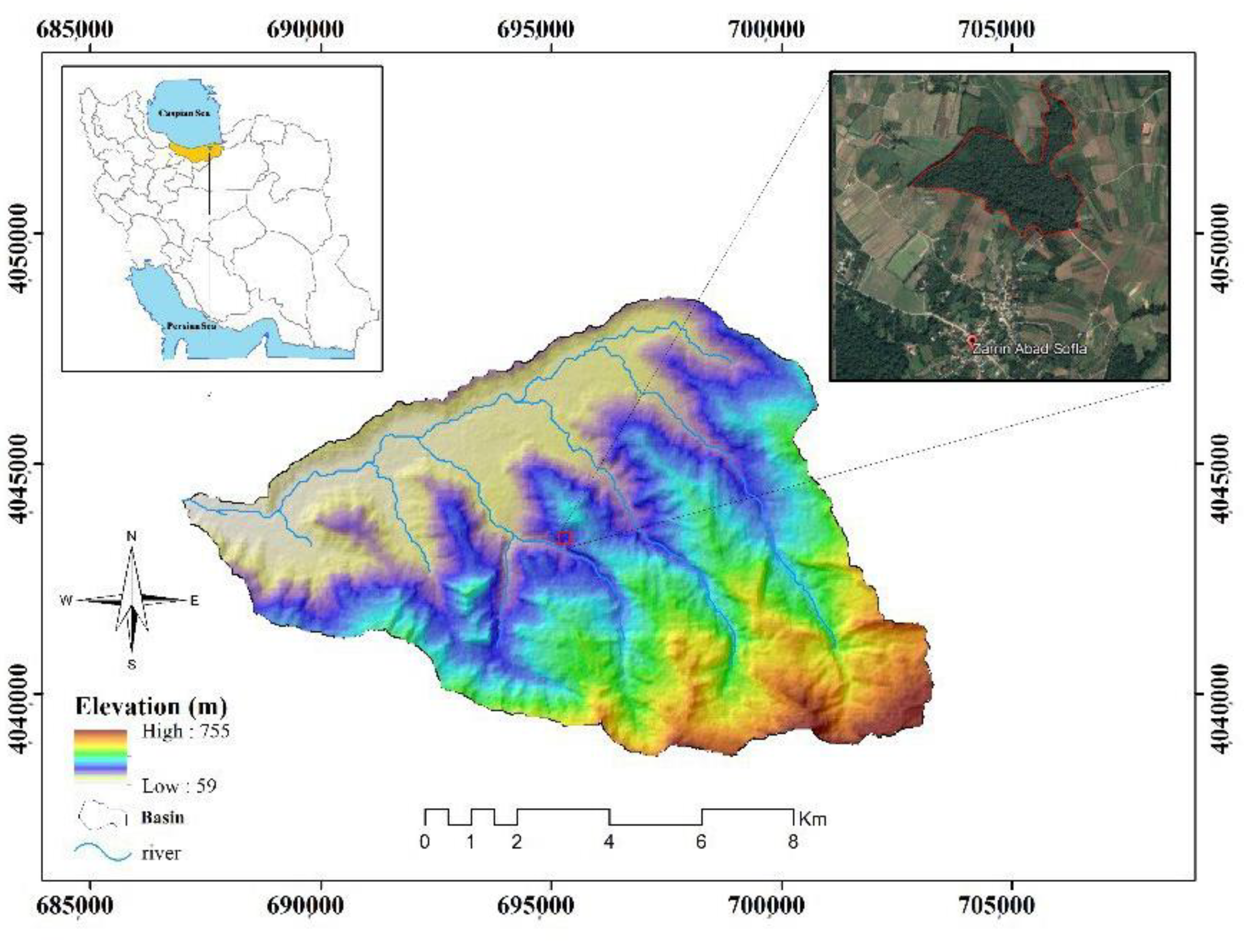
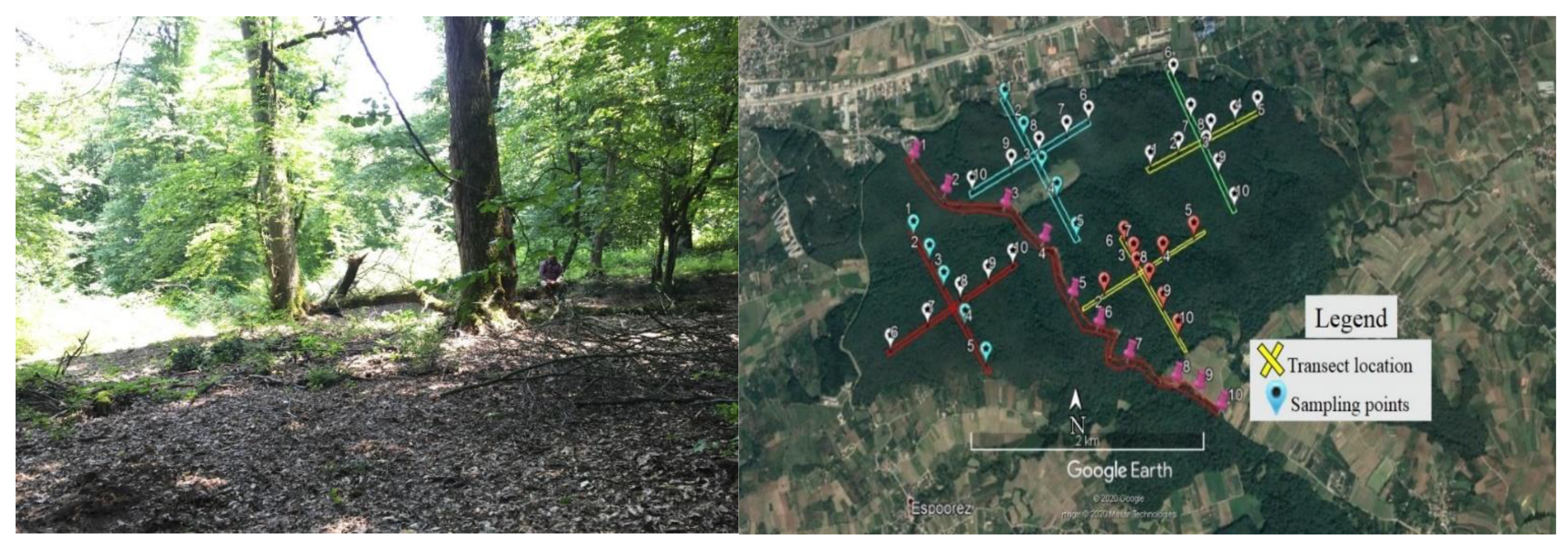
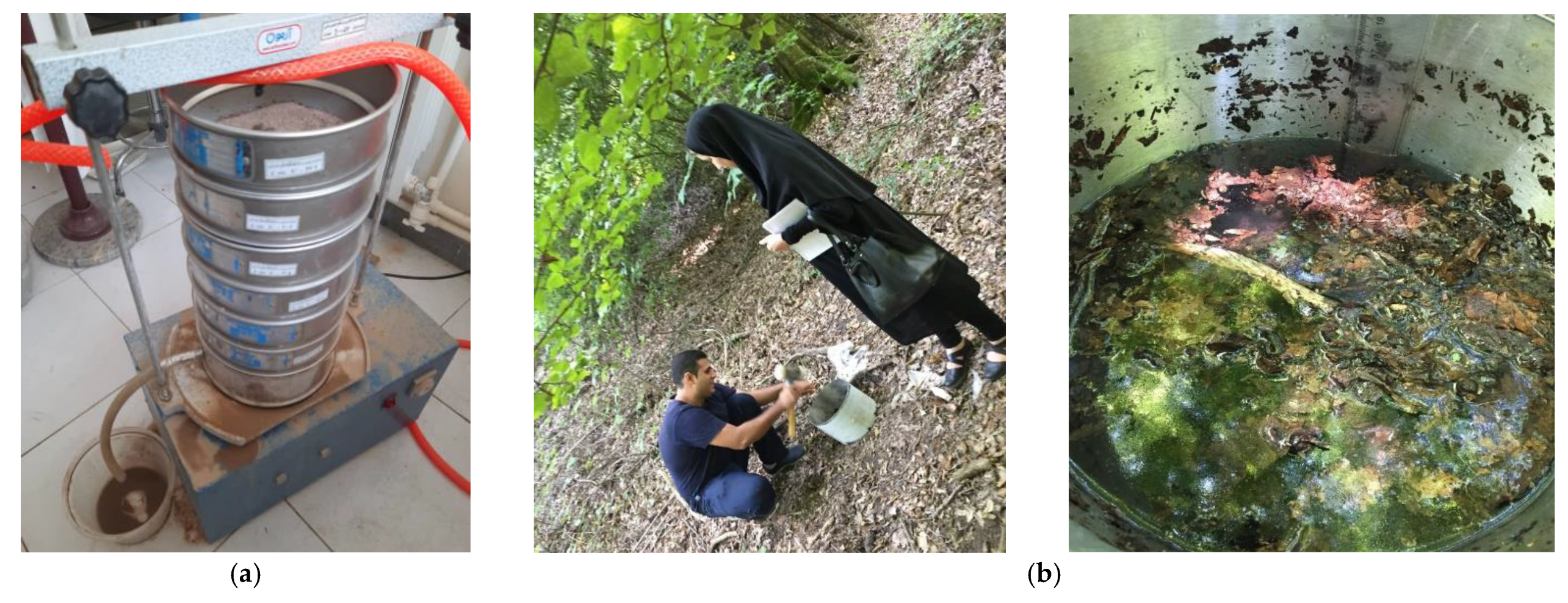
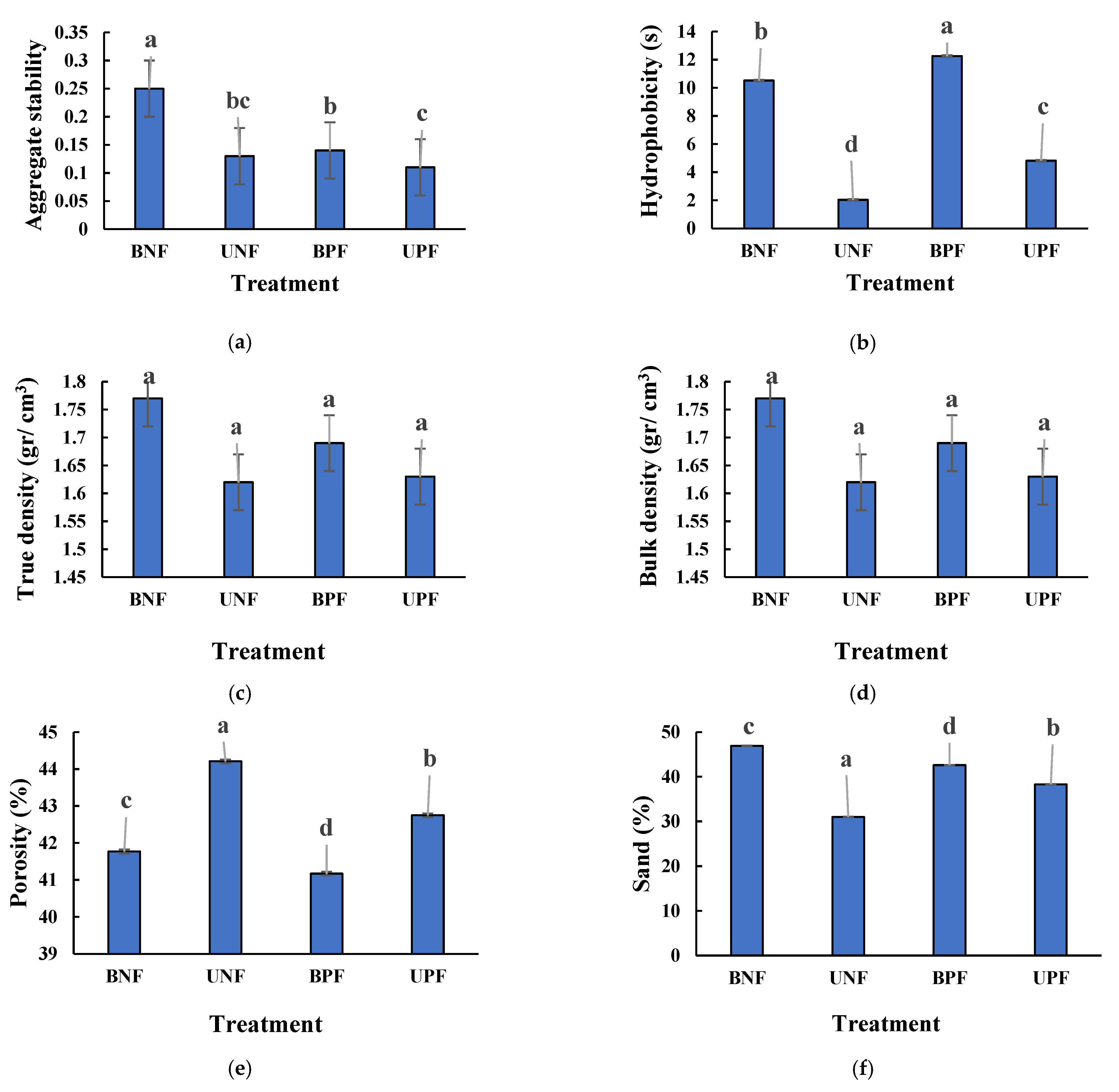
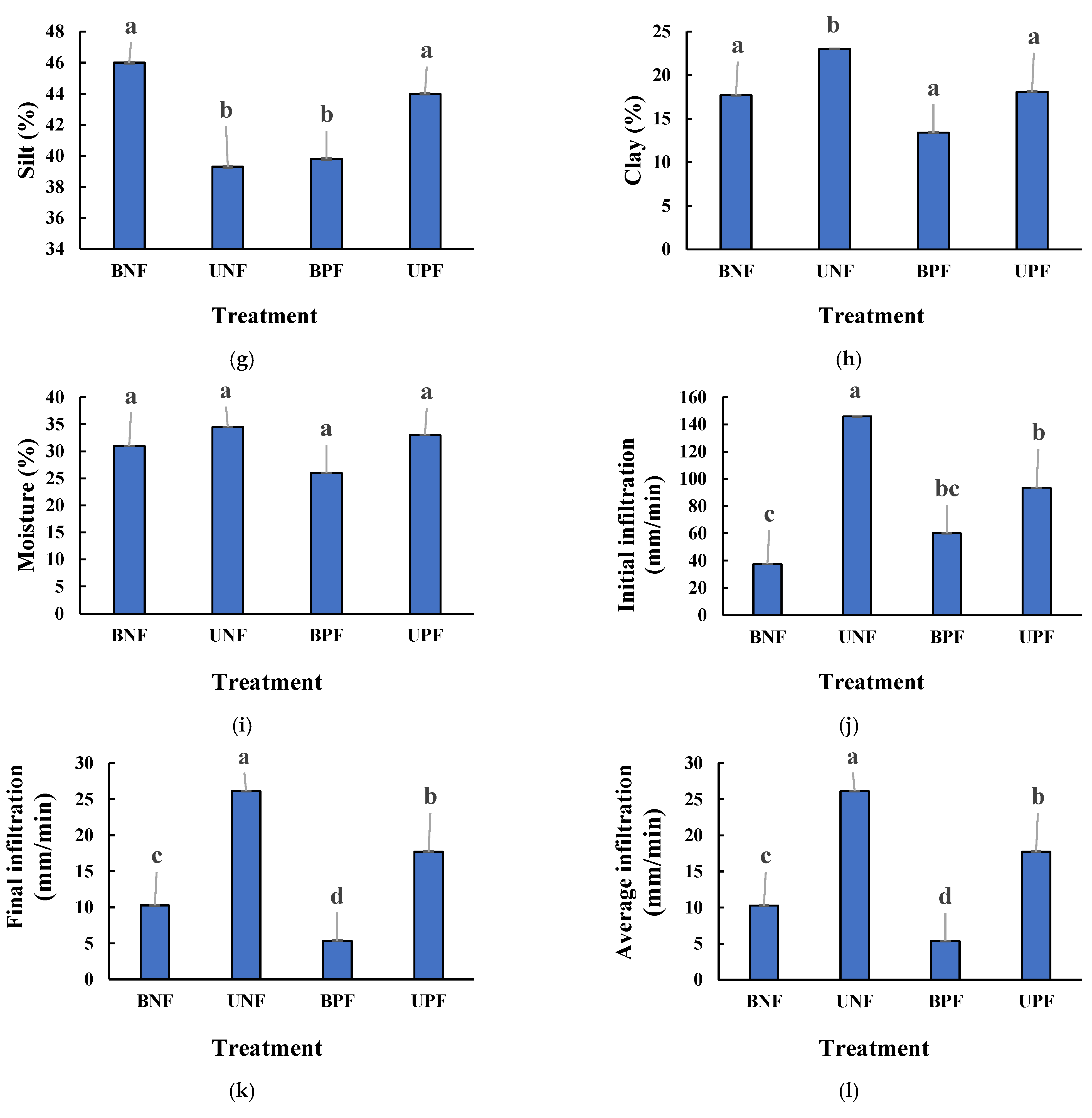
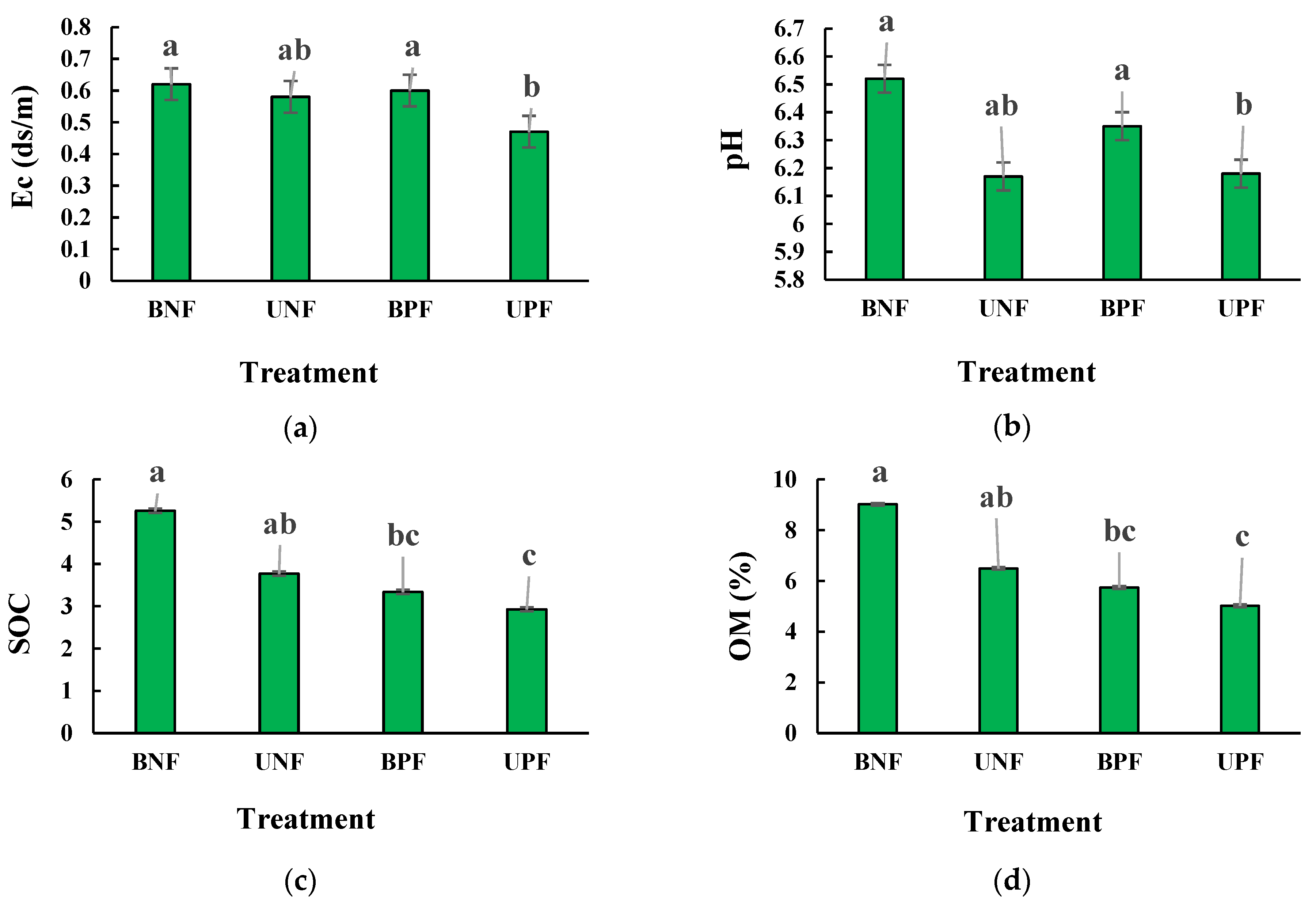
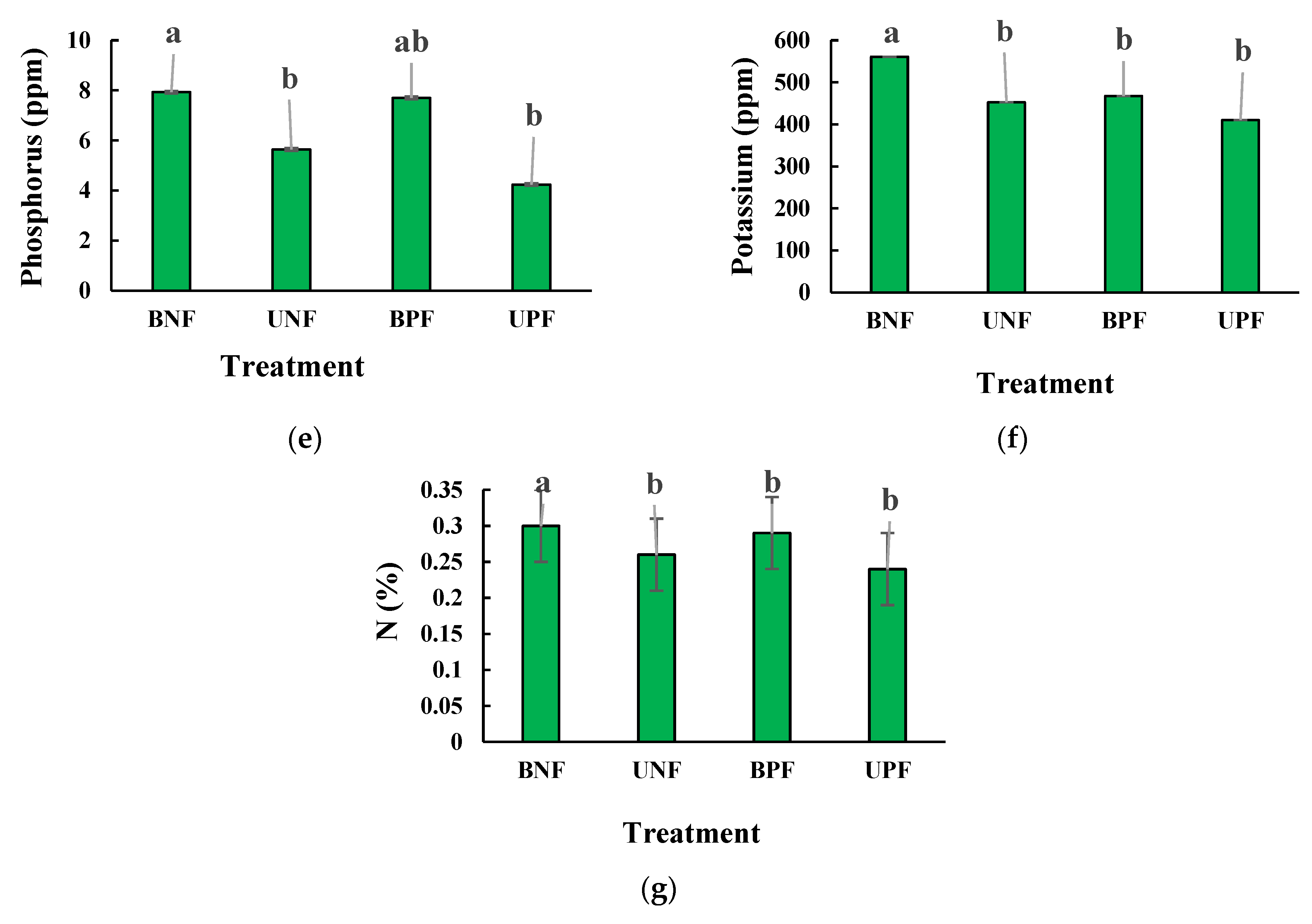
| Hydrophobicity Level | Time of WDPT (s) |
|---|---|
| No hydrophobicity | <5 |
| Low hydrophobicity | 5–60 |
| High hydrophobicity | 60–600 |
| Severe hydrophobicity | 600–3600 |
| Very severe hydrophobicity | >3600 |
| Factor | Treatment | F | Sig |
|---|---|---|---|
| Aggregate stability (%) | Fire | 20.229 | 0.000 ** |
| Plot type | 65.191 | 0.000 ** | |
| Fire × Plot type | 48.864 | 0.000 ** | |
| Hydrophobicity | Fire | 370.778 | 0.000 ** |
| Plot type | 29.983 | 0.000 ** | |
| Fire × Plot type | 1.611 | 0.21 *** | |
| Bulk density | Fire | 0.833 | 0.37 *** |
| Plot type | 0.084 | 0.77 *** | |
| Fire × Plot type | 1.17 | 0.68 *** | |
| True density | Fire | 1.217 | 0.267 *** |
| Plot type | 5.345 | 0.057 *** | |
| Fire × Plot type | 0.105 | 0.74 *** | |
| Porosity | Fire | 0.562 | 0.458 *** |
| Plot type | 0 | 0.994 *** | |
| Fire × Plot type | 0.129 | 0.722 *** | |
| Sand (%) | Fire | 0.583 | 0.45 *** |
| Plot type | 22.762 | 0.000 ** | |
| Fire × Plot type | 7.712 | 0.009 ** | |
| Clay (%) | Fire | 0.007 | 0.935 *** |
| Plot type | 10.179 | 0.003 ** | |
| Fire × Plot type | 11.783 | 0.002 ** | |
| Silt (%) | Fire | 0.749 | 0.393 *** |
| Plot type | 10.652 | 0.002 ** | |
| Fire × Plot type | 0.405 | 0.528 *** | |
| Soil moisture | Fire | 3.36 | 0.07 *** |
| Plot type | 1.374 | 0.2 *** | |
| Fire × Plot type | 0.363 | 0.5 *** | |
| Initial infiltration (mm/min) | Fire | 8.71 | 0.02 * |
| Plot type | 1.39 | 0.27 *** | |
| Fire × Plot type | 31.27 | 0.0001 ** | |
| Final infiltration (mm/min) | Fire | 496.9 | 0.000 ** |
| Plot type | 502.475 | 0.000 ** | |
| Fire × Plot type | 67.303 | 0.000 ** | |
| Average infiltration (mm/min) | Fire | 2.171 | 0.18 *** |
| Plot type | 6.125 | 0.035 * | |
| Fire × Plot type | 36.317 | 0.000 ** |
| Hydrophobic Level | OM | ||
|---|---|---|---|
| Hydrophobic level | Pearson correlation | 1 | −0.194 |
| Sig | 0.232 *** | ||
| Hydrophobic level | Organic material | ||
| OM | Pearson correlation | −0.194 | 1 |
| Sig | 0.232 *** | ||
| Factor | Treatment | DF | F | Sig |
|---|---|---|---|---|
| pH | Fire | 1 | 9.447 | 0.004 ** |
| Plot type | 1 | 0.87 | 0.357 *** | |
| Fire × Plot type | 1 | 1.113 | 0.294 *** | |
| Electrical conductivity | Fire | 1 | 3.91 | 0.04 * |
| Plot type | 1 | 2.509 | 0.122 *** | |
| Fire × Plot type | 1 | 1.12 | 0.297 *** | |
| Organic carbon (OC) (%) | Fire | 1 | 1.167 | 0.28 *** |
| Plot type | 1 | 3.891 | 0.04 * | |
| Fire × Plot type | 1 | 26.419 | 0.000 ** | |
| Phosphorus (ppm) | Fire | 1 | 1.06 | 0.3 *** |
| Plot type | 1 | 0.4 | 0.53 *** | |
| Fire × Plot type | 1 | 11.129 | 0.002 ** | |
| Potassium (ppm) | Fire | 1 | 1.625 | 0.2 |
| Plot type | 1 | 8.758 | 0.005 ** | |
| Fire × Plot type | 1 | 12.595 | 0.001 ** | |
| STN (%) | Fire | 1 | 5.94 | 0.02 * |
| Plot type | 1 | 6.636 | 0.014 * | |
| Fire × Plot type | 1 | 0.397 | 0.53 *** |
Publisher’s Note: MDPI stays neutral with regard to jurisdictional claims in published maps and institutional affiliations. |
© 2022 by the authors. Licensee MDPI, Basel, Switzerland. This article is an open access article distributed under the terms and conditions of the Creative Commons Attribution (CC BY) license (https://creativecommons.org/licenses/by/4.0/).
Share and Cite
Fadaei, Z.; Kavian, A.; Solaimani, K.; Sarabsoreh, L.Z.; Kalehhouei, M.; Zuazo, V.H.D.; Rodrigo-Comino, J. The Response of Soil Physicochemical Properties in the Hyrcanian Forests of Iran to Forest Fire Events. Fire 2022, 5, 195. https://doi.org/10.3390/fire5060195
Fadaei Z, Kavian A, Solaimani K, Sarabsoreh LZ, Kalehhouei M, Zuazo VHD, Rodrigo-Comino J. The Response of Soil Physicochemical Properties in the Hyrcanian Forests of Iran to Forest Fire Events. Fire. 2022; 5(6):195. https://doi.org/10.3390/fire5060195
Chicago/Turabian StyleFadaei, Zahra, Ataollah Kavian, Karim Solaimani, Leila Zandi Sarabsoreh, Mahin Kalehhouei, Víctor Hugo Durán Zuazo, and Jesus Rodrigo-Comino. 2022. "The Response of Soil Physicochemical Properties in the Hyrcanian Forests of Iran to Forest Fire Events" Fire 5, no. 6: 195. https://doi.org/10.3390/fire5060195
APA StyleFadaei, Z., Kavian, A., Solaimani, K., Sarabsoreh, L. Z., Kalehhouei, M., Zuazo, V. H. D., & Rodrigo-Comino, J. (2022). The Response of Soil Physicochemical Properties in the Hyrcanian Forests of Iran to Forest Fire Events. Fire, 5(6), 195. https://doi.org/10.3390/fire5060195








